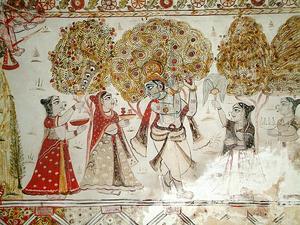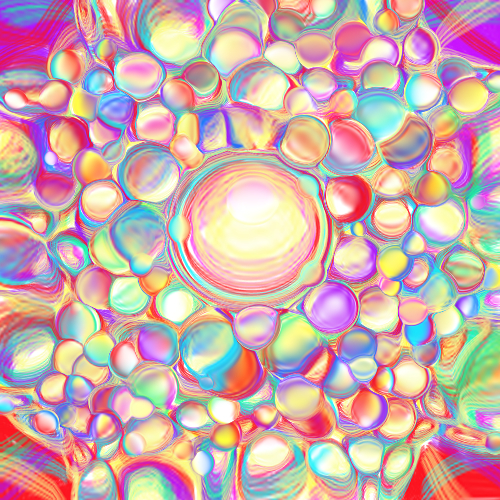|
Bhakti Yoga - The Yoga of Devotion - Part 2
|
|
|
The Yoga of Devotion is not limited to Hinduism and is also a part of Christianity. The poems of St. John of the Cross and the writings of Saint Teresa of Avila are immersed in the Love of God. In his poem, ‘The Dark Night of the Soul’, St. John of the Cross reveals his ecstatic experience of Union:
One dark night,
fired with love's urgent longings
- ah, the sheer grace! -
I went out unseen,
my house being now all stilled.
In darkness, and secure,
by the secret ladder, disguised,
- ah, the sheer grace! -
in darkness and concealment,
my house being now all stilled.
On that glad night,
in secret, for no one saw me,
nor did I look at anything,
with no other light or guide
than the one that burned in my heart.
This guided me
more surely than the light of noon
to where he was awaiting me
- him I knew so well -
there in a place where no one appeared.
O guiding night!
O night more lovely than the dawn!
O night that has united
the Lover with his beloved,
transforming the beloved in her Lover.
Upon my flowering breast
which I kept wholly for him alone,
there he lay sleeping,
and I caressing him
there in a breeze from the fanning cedars.
When the breeze blew from the turret,
as I parted his hair,
it wounded my neck
with its gentle hand,
suspending all my senses.
I abandoned and forgot myself,
laying my face on my Beloved;
all things ceased; I went out from myself,
leaving my cares
forgotten among the lilies.
 Saint
Teresa of Avila (1515-1582) was the Spanish nun who founded the Carmelites. Her
ecstatic mystical experiences of union are well known, and the famous Italian
sculptor Giovanni Lorenzo Bernini carved one of the most magnificent of all his
works in marble to immortalize her. Teresa was a beautiful woman with a keen
intelligence and a sense of humor. Her love for God led her to a vision of an
angel that pierced her heart with a golden spear - in others words opened her
heart chakra.
Saint
Teresa of Avila (1515-1582) was the Spanish nun who founded the Carmelites. Her
ecstatic mystical experiences of union are well known, and the famous Italian
sculptor Giovanni Lorenzo Bernini carved one of the most magnificent of all his
works in marble to immortalize her. Teresa was a beautiful woman with a keen
intelligence and a sense of humor. Her love for God led her to a vision of an
angel that pierced her heart with a golden spear - in others words opened her
heart chakra.
‘Teresa described the soul's intense desire for God in the language of erotic passion. In this, she belongs to a long tradition of mystical experience that is known as bridal mysticism’ (aras.org/se_ecstasy.html). In her own words:
It pleased our Lord that I should see the following vision a number of times. I saw an angel near me, on the left side, in bodily form. This I am not wont to see, save very rarely.... In this vision it pleased the Lord that I should see it thus. He was not tall, but short, marvelously beautiful, with a face which shone as though he were one of the highest of the angels, who seem to be all of fire: they must be those whom we call Seraphim....
I saw in his hands a long golden spear, and at the point of the iron there seemed to be a little fire. This I thought that he thrust several times into my heart, and that it penetrated to my entrails. When he drew out the spear he seemed to be drawing them with it, leaving me all on fire with a wondrous love for God. The pain was so great that it caused me to utter several moans; and yet so exceeding sweet is this greatest of pains that it is impossible to desire to be rid of it, or for the soul to be content with less than God. (Peers, 197 - aras.org/se_ecstasy.html).
It is this possibility of ecstatic Union with the Creator that sets Hinduism apart from the Semitic religions. The Jewish faith and that of Islam are strictly monotheistic in the belief that the one God remains forever distinct from humanity (Triadic Mysticism - Paul E. Murphy). Mysticism was later reintroduced into Islam by ‘esoteric Shia and Sufi traditions’ (ibid.).
 The
Tomb in Kashmir
The
Tomb in Kashmir
Christianity's departure from Judaism included ‘insights specific to the Indic religions’ (ibid.). This insight might be evidence of the stories that Jesus was trained in India and went back to Kashmir to die. There is a tomb known as the ‘Rauza Bal’ in the Kan Yar district of Srinagar Kashmir. This tomb is said to contain the body of Jesus who spent his later years in Kashmir as a respected teacher and healer.
The Indic insights that influenced Christianity, according to Paul E. Murphy are: ‘a belief of a plurality in the divine consonant with divine unity (interpreted by Christians as the Trinity); the humanization of God (the Incarnation); supreme bliss as union with the divine (for Christianity, the beatific Vision); the realization of this bliss through gratuitous divine election (grace); and the accessibility of the divine through numinous visible symbols (image cults - devotion to persons through their images)’ (ibid.).
The Dark Night of Shiva
Devotional Yoga is also found in the writings of Kashmir Saivism. Bhatta Narayana (855-83), Utpaladeva (900-950), and Lalla (14th century) are cited as Saivites who practiced devotion. Utpaladeva speaks of the mystical night of Shiva in his devotional songs.
Where the sun, moon, and all other stars
Set at the same time,
There rises the radiant Night of Shiva,
Spreading a splendour of its own.
- Utpaladeva’s Shivastotravali IV.22
The Kashmir Saivite Abhinavagupta ‘pays homage to the undifferentiated and ineffable Shiva, the Mystical Night (Sivaratri): Light of all Lights, darkness of all darknesses!’ (P.E.Murphy). God is the All and the ‘goal of life prescribed by these Saivas is the recognition and direct realization of the absolute Godhead as one’s own basic nature’ (Paramarthasara of Abhinavagupta).
Poetry is often the consequence of mystical experiences and is written after such blissful occasions. Those who directly experience God’s Love are forever transformed by the force that purifies and ‘plays an essential role in preparing the way to illumination and in stabilizing it once it has been attained’ (P.E.Murphy).
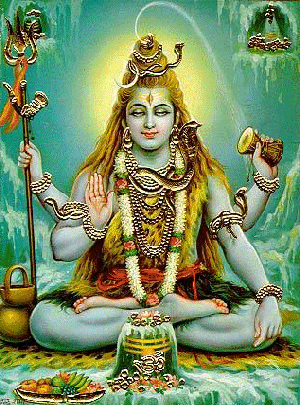
Let me, without obstacles,
Behold only you, Lord,
Everywhere, all the time ...
- Utpaladeva’s Shivastotravali XII.14
In the lake of my mind, spilling over
With the bliss of the memory of your form,
May the lotuses of the pair of your feet
Ever bloom, effusing
Nectar most delicious and sublime.
- Ibid.IX.16
What else remains to be desired
By those rolling in the wealth of devotion?
- Ibid.XX. 11
As though saturated with the wine
Of the nectar of devotion,
With vital organs radiating with delight,
The adventurous ones dance through the night ...
- Ibid.XX.20
I have only touched on a few of the devotional writings which I love and revere. There is Princess Meera (Mirabai), Kalidasa, Tukaram, and Tulsidas, just to name a few from Hinduism. From the Sufis there is the lady Rabia al Basri, the well known Rumi, and Kabir’s couplets. And so many others who will guide you and inspire you, if you should decide to take the path that embraces devotional Love for the God within you that dwells in the secret cave in the Heart.
The Bhagavad Gita, Book XII continued ...
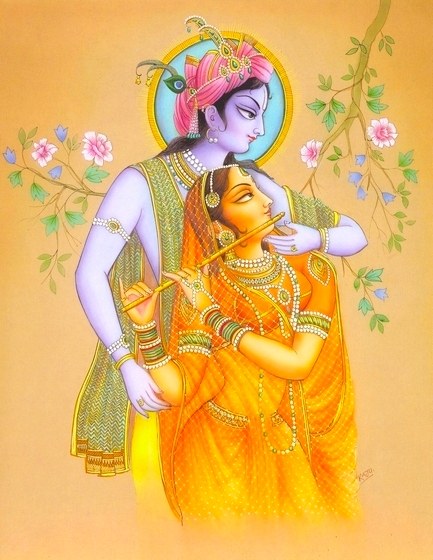 The
Bhagavad Gita recommends that the one who aspires to liberation (moksha) and
similitude (sadharmya) combine all three paths, knowledge (jnana), altruistic
works (karma), and devotion (bhakti).
The
Bhagavad Gita recommends that the one who aspires to liberation (moksha) and
similitude (sadharmya) combine all three paths, knowledge (jnana), altruistic
works (karma), and devotion (bhakti).
Who hateth nought
Of all which lives, living himself benign,
Compassionate, from arrogance exempt,
Exempt from love of self, unchangeable
By good or ill; patient, contented, firm
In faith, mastering himself, true to his word,
Seeking Me, heart and soul; vowed unto Me,-
That man I love!
Another sign that your consciousness has reached the level of similarity (sadharmya) with God would be that you could find no hatred in your heart for any being. You would be like the Creator in the sense that you would feel like a friend (maitras) and remain compassionate (karunas) to all beings.
In your identification with the All there would be no room for the small identity ego-self. You would have no need to be attached to particular possessions or people, or even to care about the ever passing phases of pain and pleasure, sama-duhkha-sukhas (XII.13).
Who troubleth not his kind,
And is not troubled by them; clear of wrath,
Living too high for gladness, grief, or fear,
That man I love!
Who, dwelling quiet-eyed,
Stainless, serene, well-balanced, unperplexed,
Working with Me, yet from all works detached,
That man I love!
The yogin who lives always in the state of contentment (samtustas satatam), with the small ego-self subdued, whose resolve is firm, and who is devoted (yo madbhaktah) to the God-within is beloved by and dear (sa me priyah) to the Supreme Lord (XII.14).
सन्तुष्टः
सततं
योगी
यतात्मा
दृढनिश्चयः
.
मय्यर्पितमनोबुद्धिर्यो
मद्भक्तः
स
मे
प्रियः
.. १२-
१४..
saṃtuṣṭaḥ satataṃ yogī yatātmā
dṛḍhaniścayaḥ
mayy arpitamanobuddhir yo madbhaktaḥ sa me
priyaḥ 12.14
This state of contentment is a higher frequency that bears little to no resemblance to the ordinary concepts of being relaxed or satisfied. This contentment is a subtle yet entirely powerful feeling that deeply permeates your entire being and spreads out into the universe.
Who, fixed in faith on Me,
Dotes upon none, scorns none; rejoices not,
And grieves not, letting good or evil hap
Light when it will, and when it will depart,
That man I love!
When we Realize that we are the All, none is dearer to us than any other. We are All! This is evidence of our Union with the Creator who holds all of creation in affection with Divine impartiality. When we see another doing anything, we do not judge them; for we know they are us, on their own journey moving in the self-perpetuating cycles of time through the polarities in the temporal illusory hologram.
We do act selflessly for the well-being of the world, but we act in the understanding that good & evil come and go endlessly. Our commitment to a better world emerges from our earned higher consciousness, and not from any ego need.
Who, unto friend and foe
Keeping an equal heart, with equal mind
Bears shame and glory; with an equal peace
Takes heat and cold, pleasure and pain;
The small identity ego-self is ever concerned with its image. Do people like you? What do they think of you? The enlightened being knows that the ever fluctuating states of friendship and enmity, shame and glory are the result of guna-maya. They come and they go quite predictably.
All beings are moving in cycles, either towards the peak of a wave or heading down to the trough of another. The polarities of heat and cold, pleasure and pain all come and go. The enlightened remain unconcerned. ‘This too will pass.’
abides
Quit of desires, hears praise or calumny
In passionless restraint, unmoved by each;
Linked by no ties to earth, steadfast in Me,
That man I love!
The enlightened belong to none but God. Their ties are no longer earthly. Love for the One replaces and subsumes all love that seeks attachment. What or who can you desire in this world when you have Become the whole world?
When others praise or criticize you, you realize that their words are only the product of their shifting, fluctuating, ever changing gunas. Without the Knowledge of Wisdom - what the deluded love one day, they despise the next. The enlightened are no longer needy for anyone or anything, for they have the Love of God. They are dear to the Supreme Being (me priyah) and that is everything!
But most of all I love
Those happy ones to whom 'tis life to live
In single fervid faith and love unseeing,
Drinking the blessed Amrit [Nectar] of my Being!
The enlightened who live in the consciousness of Love, see the presence of the Supreme Self (Paramatman) everywhere, in every being (XII.15-20). God is in a summer breeze, the shimmering leaves of the trees, the grand sparkling stars high above, the small creatures below. God is in the ones who care and the ones who don’t, the ones who envy and the ones who are happy. The enlightened see and feel God’s presence in all places, all people, all the time, and thus they live Loving the All in a state of intoxicated joy filled Wisdom - the Nectar of God’s Being!
Devotion in the Kali Yuga
Truth is arduous if not impossible to come by in the Kali Yuga. The written word is a ‘symptom’ of the Kali Yuga because writing does little to convey the true deepest essence of realities beyond apparent density. Even the sacred texts can be altered by what one scholar describes as ‘additions, interpolations, abridgment, omissions, etc.’
In other cycles of time, for example the Satya [Krita] Yuga, the Golden Era and Age of Wisdom, we communicate mind-to-mind and thus lies are not possible. But here in the Kali, lies dominate our current temporal illusory hologram, liars rule our world, and sadly people have come the ‘prefer false ideas’, which is yet another symptom of our current Age of Confusion.
The only remaining pure frequency is the Love in the Heart
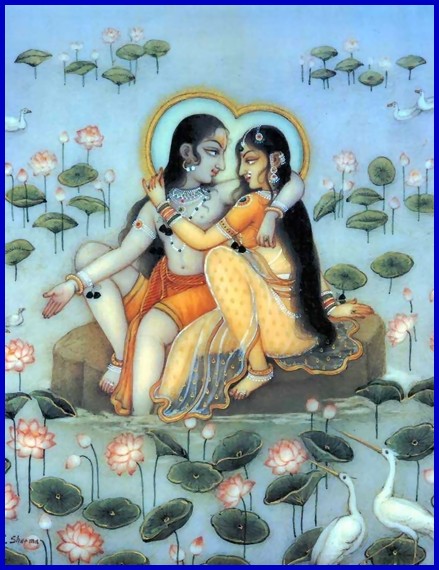 I
think of Krishna as God Realized in a human form – in other words, he
represents the highest ideal of humanity in the sense that he was totally One
with God. In the west this state of being is often spoken of as Christ
Consciousness. When a person in human form realizes the God-within, they become
enlightened and in the terminology of western mysticism gain Christ
Consciousness.
I
think of Krishna as God Realized in a human form – in other words, he
represents the highest ideal of humanity in the sense that he was totally One
with God. In the west this state of being is often spoken of as Christ
Consciousness. When a person in human form realizes the God-within, they become
enlightened and in the terminology of western mysticism gain Christ
Consciousness.
There are many men and women throughout time who have achieved enlightenment and Realized the God-within them, but not all of them have taken on such overwhelmingly immense spiritual tasks, as did Krishna and Jesus.
Krishna left this earth at the end of the last Yuga, the Dvapara, after the Great War described in the Mahabharata. The Bhagavad Gita, contained within the Mahabharata, is Krishna’s discourse to Arjuna the greatest warrior of that time. Krishna knows that the Kali Yuga is coming upon mankind. He realizes that human consciousness will soon be ‘cooked by time’ and that ignorance and delusion will permeate the temporal illusory hologram; and so he explains the efficacy of Devotion to achieve Union, Bhakti (devotion) Yoga (union), for the Kali Yuga.
Devotion as a means to focus consciousness
Krishna is the ideal of a totally God-Realized man. He represents our deepest Self and the ultimate goal for us all. Krishna teaches us to remain immersed and absorbed in the consciousness of the God-within us. Devotion is a way to move into and keep our consciousness fixed on higher frequency waveforms so that the God-within us may reveal Itself to us through the power of Grace.
No one can free himself or herself from the power of Guna-Maya without the Grace of God. God created the three GUNAS to bind Itself in this temporal illusory holographic universe. Only the God-within you can liberate (moksha) you from these powerful forces, which are designed to enchant, delude, and bind. This is why you need to form a relationship with the God-within you, and to transfer over time the focus of your consciousness from the unreal, the small identity ego-self you have always falsely imagined you to be, into the Real, the Self-Atman within you.
Krishna’s Cosmic Lifeboat
This temporal illusory holographic universe is a vast ocean of consciousness. Bhakti Yoga, devotion to the Supreme Self (Paramatman), and the words of Krishna Vasudeva in the Bhagavad Gita are our cosmic lifeboat, which allows us to safely cross over the spectrum of myriad waveforms that toss us around tsunami style, deluding and confusing. This boat can sail us Home back to our original state, in Divine Union to the God-within who waits patiently in our Heart.
Warnings on Bhakti
Bhakti Yoga can be a bit of a slippery slope, because the practice of devotion may lead you to become confused. This confusion may take the form of perceiving the object or being you are devoted to as forever separate from and external to you the worshipper. Direct your devotion to the God within you, and not ultimately to any separate external deity.
Always keep in mind that - Everything is God!
VASUDEVAH SARVAM ITI
Do not allow your consciousness to become trapped in the self-created illusion of separation through a cherished image and by your own spiritual practices - practices that were originally designed to set you free from the appearance of multiplicity and the consequent bondage of the temporal illusory hologram.
I suppose this potential for entrapment and confusion is again one more way the Creator is here engaging in the adventure of Time & Space. It’s all about the love of Play. This going Home is sometimes a bit tricky - the proverbial Razor’s Edge!
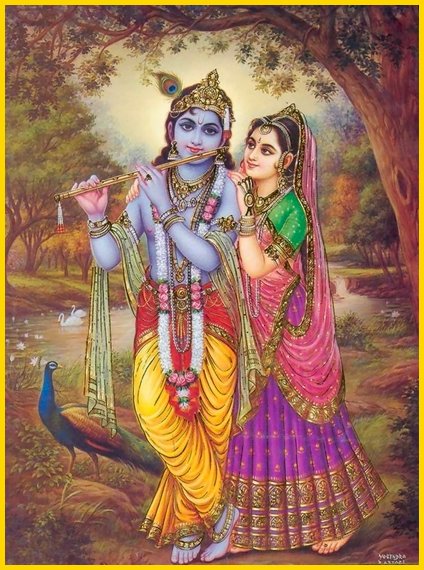 Only
You!
Only
You!
Oh, Lord!
Let me love you dearly, every day,
In every moment, let there be a way
That I forget the boundary
So long divided You from me.
There is a place where we will stay
From which I’ll never wander,
Nestled in Your Heart of hearts,
Contented with Your Wonder.
What could e’r distract me from my Lord?
The worlds are in His eyes;
In all those years of calling Him,
At last He’s heard my cries.
There is a sweetness deep inside,
No where else is Known,
Except in the Heart of my Lord,
Who is now mine ... alone.
There is a secret room,
Only He can take me to;
His Joy lives in mine,
And every song is new.
I wish that He would hurry!
He tells me, we have Time;
But, oh! How I am longing
For His tenderness sublime ...
I am Within ...
Him ... all around,
So warm, so peaceful,
And not a sound.
I’ll not go back to things outside,
But only seek within;
My heart has now been won
By the One who makes me grin!
There is no other one for me,
How foolish all that seems;
Only You, here in my Heart,
The Source of all my dreams.
Only You, only You ...
Only You!
- V.S. Ferguson, 2006
This was inspired by a wonderful & soulful song written by the great Indian composer A.R. Rahman, on his 1997 recording Vande Mataram.
The Dark Night of the Soul
www.karmel.at/ics/john/dn.html
The Ecstasy of Saint Teresa
aras.org/se_ecstasy.html
themystica.com/mystica/articles/t/teresa_of_avila_st.html
Hindu Thought & Carmelite Mysticism
Swami Siddheswarananda
Motilal Banarsidass Publishers, 1998, Delhi
The Tomb of Jesus in Kashmir
www.tombofjesus.com/home.htm
www.spinninglobe.net/jesustomb.htm
Triadic Mysticism
The Mystical Theology of the Saivism of Kashmir
Paul E. Murphy,1986
Motilal Banarsidass Publishers, 1999, Delhi
Shaiva Devotional Songs of Kashmir
A Translation & Study of Utpaladeva’s Shivastotravali
Constantina Rhodes Bailly
Stae University of New York Press, 1987, Albany NY
Essence of the Exact Reality or Paramarthasara of Abhinavagupta
English translation & notes by B.N.Pandit
Munishiram Manoharlal, 1991, Delhi
Spiritual & Devotional Poets
www.poetseers.org/spiritual_and_devotional_poets
Krishna images courtesy of
www.vishvarupa.com/vishnu-krishna.html
